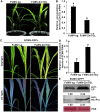A maize triacylglycerol lipase inhibits sugarcane mosaic virus infection
- PMID: 35294544
- PMCID: PMC9157127
- DOI: 10.1093/plphys/kiac126
A maize triacylglycerol lipase inhibits sugarcane mosaic virus infection
Abstract
Triacylglycerol lipase (TGL) plays critical roles in providing energy for seed germination and plant development. However, the role of TGL in regulating plant virus infection is largely unknown. In this study, we adopted affinity purification coupled with mass spectrometry and identified that a maize (Zea mays) pathogenesis-related lipase protein Z. mays TGL (ZmTGL) interacted with helper component-proteinase (HC-Pro) of sugarcane mosaic virus (SCMV). Yeast two-hybrid, luciferase complementation imaging, and bimolecular fluorescence complementation assays confirmed that ZmTGL directly interacted with SCMV HC-Pro in vitro and in vivo. The 101-460 residues of SCMV HC-Pro were important for its interaction with ZmTGL. ZmTGL and SCMV HC-Pro co-localized at the mitochondria. Silencing of ZmTGL facilitated SCMV infection, and over-expression of ZmTGL reduced the RNA silencing suppression activity, most likely through reducing HC-Pro accumulation. Our results provided evidence that the lipase hydrolase activity of ZmTGL was associated with reducing HC-Pro accumulation, activation of salicylic acid (SA)-mediated defense response, and inhibition of SCMV infection. We show that ZmTGL inhibits SCMV infection by reducing HC-Pro accumulation and activating the SA pathway.
© American Society of Plant Biologists 2022. All rights reserved. For permissions, please email: journals.permissions@oup.com.
Figures









Similar articles
-
NIa-Pro of sugarcane mosaic virus targets Corn Cysteine Protease 1 (CCP1) to undermine salicylic acid-mediated defense in maize.PLoS Pathog. 2024 Mar 14;20(3):e1012086. doi: 10.1371/journal.ppat.1012086. eCollection 2024 Mar. PLoS Pathog. 2024. PMID: 38484013 Free PMC article.
-
Maize phenylalanine ammonia-lyases contribute to resistance to Sugarcane mosaic virus infection, most likely through positive regulation of salicylic acid accumulation.Mol Plant Pathol. 2019 Oct;20(10):1365-1378. doi: 10.1111/mpp.12817. Epub 2019 Sep 5. Mol Plant Pathol. 2019. PMID: 31487111 Free PMC article.
-
A Violaxanthin Deepoxidase Interacts with a Viral Suppressor of RNA Silencing to Inhibit Virus Amplification.Plant Physiol. 2017 Dec;175(4):1774-1794. doi: 10.1104/pp.17.00638. Epub 2017 Oct 11. Plant Physiol. 2017. PMID: 29021224 Free PMC article.
-
Characterization of Maize miRNAs in Response to Synergistic Infection of Maize Chlorotic Mottle Virus and Sugarcane Mosaic Virus.Int J Mol Sci. 2019 Jun 27;20(13):3146. doi: 10.3390/ijms20133146. Int J Mol Sci. 2019. PMID: 31252649 Free PMC article.
-
Potyviral Helper-Component Protease: Multifaced Functions and Interactions with Host Proteins.Plants (Basel). 2024 Apr 29;13(9):1236. doi: 10.3390/plants13091236. Plants (Basel). 2024. PMID: 38732454 Free PMC article. Review.
Cited by
-
NIa-Pro of sugarcane mosaic virus targets Corn Cysteine Protease 1 (CCP1) to undermine salicylic acid-mediated defense in maize.PLoS Pathog. 2024 Mar 14;20(3):e1012086. doi: 10.1371/journal.ppat.1012086. eCollection 2024 Mar. PLoS Pathog. 2024. PMID: 38484013 Free PMC article.
-
The Viral Fraction Metatranscriptomes of Lake Baikal.Microorganisms. 2022 Sep 29;10(10):1937. doi: 10.3390/microorganisms10101937. Microorganisms. 2022. PMID: 36296212 Free PMC article.
-
Fighting Death for Living: Recent Advances in Molecular and Genetic Mechanisms Underlying Maize Lethal Necrosis Disease Resistance.Viruses. 2022 Dec 12;14(12):2765. doi: 10.3390/v14122765. Viruses. 2022. PMID: 36560769 Free PMC article. Review.
-
Characterizing the mono- and triacylglycerol lipase (MAGL and TAGL) genes from pearl millet (Pennisetum glaucum L.) and elucidating their dynamics with biochemical traits linked with rancidity.Planta. 2025 Feb 11;261(3):57. doi: 10.1007/s00425-025-04621-4. Planta. 2025. PMID: 39934346
-
Foxtail mosaic virus: A tool for gene function analysis in maize and other monocots.Mol Plant Pathol. 2023 Jul;24(7):811-822. doi: 10.1111/mpp.13330. Epub 2023 Apr 10. Mol Plant Pathol. 2023. PMID: 37036421 Free PMC article. Review.
References
-
- Abdelkafi S, Barouh N, Fouquet B, Endri F I, Pina M, Scheirlinckx F, Villeneuve P, Carrière F (2011) Carica papaya lipase: a naturally immobilized enzyme with interesting biochemical properties. Plant Foods Hum Nutr 66: 34–40 - PubMed
-
- Baudouin E, Charpenteau M, Roby D, Marco Y, Ranjeva R, Ranty B (1997) Functional expression of a tobacco gene related to the serine hydrolase family – esterase activity towards short-chain dinitrophenyl acylesters. Eur J Biochem 248: 700–706 - PubMed
-
- Blanc S, López-Moya J-J, Wang R, García-Lampasona S, Thornbury DW, Pirone TP (1997) A specific interaction between coat protein and helper component correlates with aphid transmission of a potyvirus. Virology 231: 141–147 - PubMed
Publication types
MeSH terms
Substances
Supplementary concepts
LinkOut - more resources
Full Text Sources

